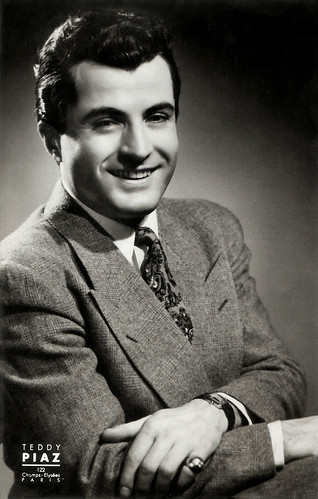
French postcard by Editions du Globe, Paris, no. 209. Photo: Studio Harcourt.

French postcard by Editions P.I., Paris, no. 1. Photo: Hélène Hapaille.
A miracle happened
Rudy Hirigoyen was born Émile Jean Baptiste Hirigoyen in 1919 in Mendionde in the heart of the French Pyrenees, in the Basque Country. Hirigoyen followed his parents to Paris in 1927. His family was of modest means, and he worked from an early age. He began his career as a hunter at the Hotel Georges V, then worked as a hairdresser for four years.
In his spare time, he sang for pleasure. Rudy was a dashing young man, small but robust, with a bright smile. Without any musical training, he won two radio talent shows in 1938. The following year, he came first in the Opéra and Opéra-Comique competitions with an aria from Giacomo Puccini's 'La Bohème', 'Que cette main est froide', ahead of 110 competitors. This success encouraged him to say goodbye to hairbrushes and curlers and to embark on a singing career.
He entered the Paris Conservatoire but was mobilised in 1939, taken prisoner and released in 1941. He was hired as a chorister at the Théâtre du Châtelet and as Maurice Vidal's ‘triplure’. A miracle happened: he sang Johann Strauss's 'Valses de Vienne' several times in 1941 and soon made a name for himself as a soloist. He was noticed by Henri Varna, who offered him a role in a tableau in one of his revues at the Casino de Paris. In 1944, he had his first successes: 'Ma belle au bois dormant', 'Au jardin de mon cœur', and 'Pastourelle à Nina'. Varna engaged him for the ‘verse comedy’ 'La Concierge est dans l'escalier' (1946) at the Palace, where he was the partner of Jane Sourza and Raymond Souplex.
As an Operetta singer, he was facing stiff competition from Luis Mariano. In 1947, Rudy took over from Mariano and performed Francis Lopez's 'La Belle de Cadix', first at the Casino-Montparnasse and then in the provinces. Rudy was later often Mariano's unofficial replacement, notably in 'Andalousie' (1954), 'Le Chanteur de Mexico' and 'Le Secret de Marco-Polo'. Rudy Hirigoyen reached his zenith in 1949 when he performed the first post-war Parisian revival of Franz Lehár's masterpiece, the operetta 'Le Pays du sourire' at the Gaîté-Lyrique.
With elegance and a rare warmth, the young singer proved himself a worthy successor to his elders, Louis Izar, Willy Thunis and José Janson. His tenor voice rose to the top with great ease, and he could hold it for a long time. This lightness combined with suppleness compensated for a lack of power in his delivery (light voices are rarely powerful) and allowed the singer never to be ‘shrill’.

French postcard by Editions P.I., Paris. Rudy Hirigoyen in 'Le Pays du Sourire', the French version of the operetta 'Das Land des Lächelns' by Franz Lehár. It was performed in 1949 at the Paris' Gaité Lyrique.
Lacking a big hit
During the 1950s, Rudy Hirigoyen went on to recreate the such operettas as 'Le Brigand d'amour' (1951), 'Les Caprices de Vichnou (1951) at the Théâtre de l'Étoile and also created new works like 'Pour toi' (music by Georges Dherain), and 'Maria-Flora' (music by Henri Betti, 1957).
He also acted in three films. The first was the musical comedy Musique en tête / Music on Your Mind (Georges Combret, Claude Orval, 1951) with Jacques Hélian and his orchestra. Three years later followed the comedy Le collège en folie / College on the Run (Henri Lepage, 1954) in which he had the lead opposite Nicole Courcel. His third and last film was the sequel, L'auberge en folie / The Crazy Hostel (Pierre Chevalier, 1956), again with Hirigoyen in the lead and now with Geneviève Kervine as his co-star.
In 1959, Francis Lopez wrote his first operetta, especially for the tenor: in 'Viva Napoli!', Rudy played a very credible Bonaparte. Viva Napoli! was performed 100 times by its creator the following year at the Théâtre Mogador. After that, productions with Hirigoyen in the French capital were few and far between. He appeared on stage in 'Méditerranée' (1964) at the Théâtre du Châtelet, and again in 'Viva Napoli' (music by Francis Lopez, 1970) at the Mogador.
Until 1987, he toured France, Belgium, Switzerland, Canada and North Africa performing works by Francis Lopez including 'La Toison d'Or', 'La Route fleurie', 'Le Prince de Madrid', and 'Gipsy'. His last creation was an operetta by Francis Lopez, 'Fandango', presented in 1987 at the Élysée-Montmartre. What Rudy Hirigoyen seems to have lacked to have the same reputation as Luis Mariano, Georges Guétary or André Dassary, is a big hit to which his name could have been attached. He made some fine creations, but not a ‘hit’.
In the 1980s, he gave singing lessons at the Cité des Artistes in Paris. Later he moved to Lyon. As the honorary president of the Friends of the Lyon Operetta Theatre, he supported the continued existence of the art of Operetta. Rudy Hirigoyen died in 2000 in Lyon, at the age of 81. He was married to Christiane Lamielle (1954-1969; divorce), Denise Bienvenu (1975-?) and Sylviane Ohanessian (1996-2000; his death). He had a daughter, Valérie. After his death, the 'Association des Amis de Rudy Hirigoyen' was set up to publish his memoirs: 'Ma vie d'opérette'.

French postcard, offered by Les Carbones Korès, 'Carboplane', no. 372.

French postcard by Editions O.P., Paris, no. 29. Photo: Teddy Piaz.
Sources: Jean-Claude Fournier (Théâtre Musical - Opérette - French), Wikipedia (French) and IMDb.
No comments:
Post a Comment